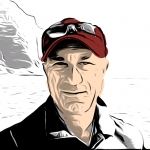 Perhaps you’ve wondered: Why did banks and traders make such bad decisions leading up to and during the 2007-2008 financial crisis? Frank Portnoy [a former derivatives trader and current professor of law and finance at the University of San Diego] , was apparently wondering the same thing. In Professor Portnoy’s case, it led to the writing of his most recent book, Wait: The Art and Science of Delay
Perhaps you’ve wondered: Why did banks and traders make such bad decisions leading up to and during the 2007-2008 financial crisis? Frank Portnoy [a former derivatives trader and current professor of law and finance at the University of San Diego] , was apparently wondering the same thing. In Professor Portnoy’s case, it led to the writing of his most recent book, Wait: The Art and Science of Delay
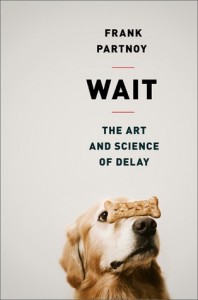 Answering the question about banks’ and traders’ bad decision-making leading up to and during the financial crisis turns out to be rather complicated. It wasn’t because the bankers were ignorant about decision-making, and decision-making flaws imbedded deeply in the human psyche. In Wait, Portnoy describes how the top executives at the now-defunct investment bank, Lehman Bros. commissioned a special training course in decision making, inviting some of the top writers and researchers on the subject, including Malcolm Gladwell, the author of Blink: The Power of Thinking Without Thinking, to come to their offices in New York and teach them how to make more good decisions, while avoiding the really bad decisions.
Answering the question about banks’ and traders’ bad decision-making leading up to and during the financial crisis turns out to be rather complicated. It wasn’t because the bankers were ignorant about decision-making, and decision-making flaws imbedded deeply in the human psyche. In Wait, Portnoy describes how the top executives at the now-defunct investment bank, Lehman Bros. commissioned a special training course in decision making, inviting some of the top writers and researchers on the subject, including Malcolm Gladwell, the author of Blink: The Power of Thinking Without Thinking, to come to their offices in New York and teach them how to make more good decisions, while avoiding the really bad decisions.
Lehman’s top two dozen execs listened to what the highly-paid speakers had to say, then they marched off–taking their copies of Blink to the trading floor–and proceeded to make a series of disastrous snap decisions that led to the firm’s downfall. Apparently, the Lehman execs only read the first two-thirds of Gladwell’s book. Blink has been interpreted as saying that making snap decisions is a good thing. The first two-thirds of Blink makes the case for that idea, but the last one-third, which people typically don’t read, is about the problematic aspects of snap decision making. Ooops!
Looking deeper, Portnoy found that little research had been done about the timing of decisions; when is the best time to actually make any decision? It seems that for every situation and every person there is an optimal amount of delay. I kid you not. The very idea of delay in the context of decision-making is, for me, rather unsettling. But the science behind the concept is compelling.
So, what is it about decision making in different time frames that is good and bad? Portnoy starts this journey of discovery in the world of high frequency trading (“HFT”). HFT is the use of sophisticated technological tools to trade securities like stocks or options. It has a number of interesting characteristics, but for our purposes, the most significant is that HFT is very sensitive to the processing speed of markets and of the HFT traders’ own access to the market. I’m personally not a big fan of HFT, for a number of reasons. Here’s a link to a recent NY Times article that might make you think twice–or three times–about HFT and its impact on financial markets. Regardless of whether you love, hate, or are indifferent about HFT, you’d think that in such an environment, faster would always be better. That proves to be a bad assumption; in HFT faster isn’t necessarily better. Getting faster can actually make you get worse.
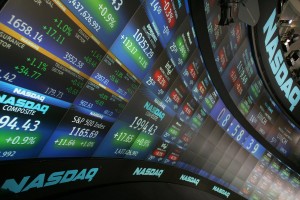 A high frequency trader called UNX in Burbank, CA, had been at the bottom of the league tables, which rank investment firms relative performance. UNX brought in new CEO, Scott Harrison, who instituted a new HFT algorithm, flipped the switch and moved to the top decile of the league tables. Their execution model allowed for a trade execution time of 65 milliseconds (“m-sec”). Harrison then thought, if 65 m-sec is good, faster would be even better. The only way to get much faster , given that electronic trading instructions travel at the speed of light, was to move the trading computers closer to the stock exchanges in New York City [Southern California to NYC at the speed of light is about 30 m-sec]. UNX packed up and moved its computer trading operations to New York, to co-locate next to the New York Stock Exchange, flipped the switch, and, as expected, lowered execution time to 35 m-sec. What they didn’t expect is that with a 35 m-sec execution time, their rank on the league tables would drop to the bottom decile. Harrison then rigged the trading computers to slow them down to 65 m-sec; performance leaped back to the top of league tables.
A high frequency trader called UNX in Burbank, CA, had been at the bottom of the league tables, which rank investment firms relative performance. UNX brought in new CEO, Scott Harrison, who instituted a new HFT algorithm, flipped the switch and moved to the top decile of the league tables. Their execution model allowed for a trade execution time of 65 milliseconds (“m-sec”). Harrison then thought, if 65 m-sec is good, faster would be even better. The only way to get much faster , given that electronic trading instructions travel at the speed of light, was to move the trading computers closer to the stock exchanges in New York City [Southern California to NYC at the speed of light is about 30 m-sec]. UNX packed up and moved its computer trading operations to New York, to co-locate next to the New York Stock Exchange, flipped the switch, and, as expected, lowered execution time to 35 m-sec. What they didn’t expect is that with a 35 m-sec execution time, their rank on the league tables would drop to the bottom decile. Harrison then rigged the trading computers to slow them down to 65 m-sec; performance leaped back to the top of league tables.
Portnoy suggests that there is an optimal delay time for everything. In another example, we consider that humans don’t perceive speech delays of less than 150 m-sec. Telephone companies, at considerable expense, have the technological capability to reduce the speech transmission delay to as low as 1 m-sec. But it wouldn’t be worth it, since the optimal delay–the slowest speed at which speech delay is imperceptible–is just under 150 m-sec; getting faster isn’t necessarily better.
Now, it’s true that the optimal delay for high frequency trading may not stay at 65 m-sec. Trading systems and trading algorithms are always subject to improvement. Human aural systems may also evolve and improve, reducing the optimal delay for voice transmission systems. Optimal delay is generally going to be a moving target; it may also depend on your strategy. For example, how should you manage emails? Should you respond immediately, wait an hour, wait 3 hours, set aside a special time every day to deal with email? Your answer will depend on what you are trying to accomplish, and how you try to balance competing needs.
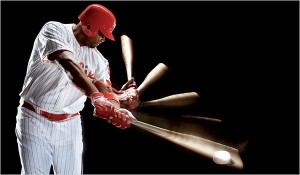 And no one is suggesting that you delay simply for the sake of delay. What you want to do is maximize the time you get to make a decision. For further insight into decision timing, Portnoy turns to the world of super fast sports: professional tennis players returning 120-mph serves, or Major League Baseball hitters swinging at 98-mph fastballs. In this super-fast world, the entire act is completed in less than 500 m-sec. (As a point of reference, the speed of a blink of an eye for humans averages between 300 and 400 m-sec.) The easy answer is that the best players in super-fast sports simply have faster reflexes. But the best serve returners and batters don’t necessarily have quicker reaction times. So what is it that makes them the best?
And no one is suggesting that you delay simply for the sake of delay. What you want to do is maximize the time you get to make a decision. For further insight into decision timing, Portnoy turns to the world of super fast sports: professional tennis players returning 120-mph serves, or Major League Baseball hitters swinging at 98-mph fastballs. In this super-fast world, the entire act is completed in less than 500 m-sec. (As a point of reference, the speed of a blink of an eye for humans averages between 300 and 400 m-sec.) The easy answer is that the best players in super-fast sports simply have faster reflexes. But the best serve returners and batters don’t necessarily have quicker reaction times. So what is it that makes them the best?
In a 500 m-sec world, if you have the ability to execute the baseball swing or tennis service return faster, say in 100m-sec instead of 200 m-sec, you wind up with much more time to gather information before you execute. You’ll be able to hit that fastball out of the park, or make a great service return. Very small delays can be hugely important. In the world of professional tennis a 50 m-sec improvement in service execution speed can mean the difference between a world class professional and a very good amateur. Of course, all of this super-fast sports activity is so fast that it is clearly sub-conscious. What about the slower world that most of us make our way in? How do we determine optimal decision delay in that world?
 Well, no one studies decision making more than the military, especially tactical decision-making. John Boyd, a brilliant military strategist, developed the jet fighter tactics now taught at the Top Gun school for fighter pilots. Boyd’s tactical decision-making approach was Observe, Orient, Decide, Act, often referred to by its acronym, the OODA Loop. Boyd said that the F-15 fighter jet should be like a switchblade in a knife fight. It is very fast, but the true value of its speed is that it gives the pilot more time to observe, orient and decide, before acting. The F-15 pilot can wait until the last possible moment before committing to action, knowing that his aircraft is so much faster and more agile than his opponent’s aircraft. Action and execution speed is every bit as valuable in the 60-second world of jet fighter dogfights as it is in the 500 m-sec world of tennis and baseball.
Well, no one studies decision making more than the military, especially tactical decision-making. John Boyd, a brilliant military strategist, developed the jet fighter tactics now taught at the Top Gun school for fighter pilots. Boyd’s tactical decision-making approach was Observe, Orient, Decide, Act, often referred to by its acronym, the OODA Loop. Boyd said that the F-15 fighter jet should be like a switchblade in a knife fight. It is very fast, but the true value of its speed is that it gives the pilot more time to observe, orient and decide, before acting. The F-15 pilot can wait until the last possible moment before committing to action, knowing that his aircraft is so much faster and more agile than his opponent’s aircraft. Action and execution speed is every bit as valuable in the 60-second world of jet fighter dogfights as it is in the 500 m-sec world of tennis and baseball.
But what about the “normal” world of personal and business decisions? What is the optimal amount of delay in the world where most of us live and make our decisions? If you don’t make a decision as quickly as possible, you’re likely to be labeled a procrastinator. And procrastination has become a very bad word. Yet sometimes procrastinating–managing delay in decision-making–is precisely the right thing to do.
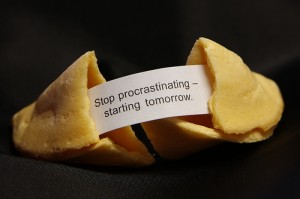 It might be time to suck it up and admit that procrastination is not necessarily a bad thing. Procrastination was once actually associated with wisdom. In it’s original usage, procrastination simply meant putting off until tomorrow what belonged to tomorrow, and was considered a virtuous and wise path. That is no longer the case. Going back to the days of the Puritans, aspects of American culture have made us feel guilty about procrastinating. The dictionary definition of procrastination today clearly infers that it is a bad thing, delaying or putting off something that urgently needs to be done.
It might be time to suck it up and admit that procrastination is not necessarily a bad thing. Procrastination was once actually associated with wisdom. In it’s original usage, procrastination simply meant putting off until tomorrow what belonged to tomorrow, and was considered a virtuous and wise path. That is no longer the case. Going back to the days of the Puritans, aspects of American culture have made us feel guilty about procrastinating. The dictionary definition of procrastination today clearly infers that it is a bad thing, delaying or putting off something that urgently needs to be done.
Business culture has become almost obsessively action-oriented, rather than focused on making good decisions. I remember working for an executive in the 1980’s who was proud of his Ready-Fire-Aim approach. He was a big fan of the Peters and Waterman book, In Search of Excellence, wherein the authors identified seven factors that contributed to organizational excellence, with the top factor, Bias for Action, considered more important than the other six combined.
In the end, the discussion about optimal delay times for decision making doesn’t provide any simple answers. I think it becomes, more than anything else, a question of priorities. There are always too many things to do; so what will we do now, what will we do later, and what will we never do? Then we have to strike a reasonable balance between “do it fast,” and “wait as long as possible to decide.”
one of your best…..I think this is applicable to SWAT…shoot or don’t shoot
To paraphrase Lincoln…..don’t decide until you have to then do it quickly
Well said Dave. We are definitely in the go slower camp. Limited dollars has that effect on a small business. We have see so may cases of successful people making deterministic decisions about their business or personal life, and end up almost losing everything (and everyone) that was important to them. By listening, thinking, writing, then reflecting so many people can give themselves time to “hear” what they wrote and “listen” to what they feel.